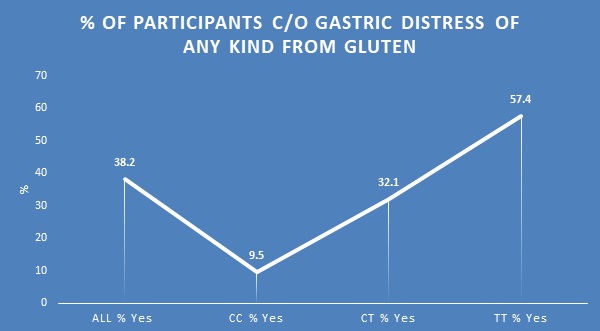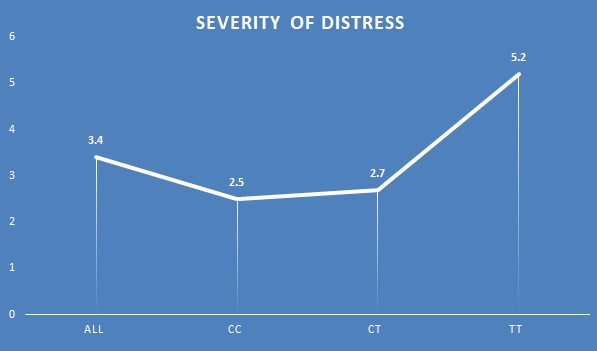Gluten is a protein contained in wheat, barley and rye and will be found in a variety of everyday food items. It allows doughs to be more elastic and pliable, this is why gluten-containing grains have been used in breads and other baked goods for many years. It can be difficult to actually know if you have intolerance to gluten as there may be little to no symptoms.
The study aims to discover if there are any correlations between gastric distress and severity of distress post gluten consumption and the variants in rs2305764 (MYO9B). The gene MYO9B encodes a member of the myosin family of actin-based molecular motor heavy chain proteins, polymorphisms in the genes are associated with celiac disease, ulcerative colitis and general autoimmunity. 89 female (24-43y/o) with no diagnosis of celiac disease were tested under a custom Illumina array in conjunction with Muhdo Health Ltd, this array analyses 1000 SNPs, one of which is rs2305764 that was read in the forward/forward orientation. Of these 21 had CC, 28 had CT and 40 had TT, there were no “no calls”. The results show that 9.5% of those with CC (
n
=21) had some form of gastric distress post gluten intake, 32.1% of those with CT (
n
=28) had some form of gastric distress post gluten intake and 57.4% of those with TT (
n
=40) had some form of gastric distress post gluten intake. The average for all participants was 38.2%. On gastric distress the average score for the CC group was 2.5 (mild – somewhat uncomfortable), the average score for the CT group was 2.7 (mild – somewhat uncomfortable) and for the TT group was 5.2 (discomfort, some pain and distress).
- Gluten
- genetics
- myo9b
- DNA
- celiac
- gluten sensitivity
- intolerance
- muhdo
*This is a preliminary search for correlations to allow for further study.
1. Introduction
Gluten is a protein contained in wheat, barley and rye and will be found in a variety of everyday food items. It allows doughs to be more elastic and pliable, this is why gluten-containing grains have been used in breads and other baked goods for many years. It can be difficult to actually know if you have intolerance to gluten as there may be little to no symptoms. Typical symptoms of intolerance include stomach pain with possible diarrhoea when gluten begins to damage the intestinal lining. The small intestines are covered with millions of little octopus like arms called villi, which pull nutrients in from our foods and absorb them into the blood stream. Our bodies create enzymes that break gluten (a protein) down, in some cases break down is hampered which may cause gastric distress and discomfort.
Celiac disease or gluten intolerance is caused by an adverse response to the intake of gluten, usually small amounts of gluten can be tolerated by some, however the variety of certain foods can prove problematic. Symptoms of intolerance are gastric distress, diarrhoea, bloating, appetite loss and malabsorption of important nutrients. The condition occurs in people who are genetically predisposed with an inappropriate immune response occurring upon gluten exposure. The majority of those with celiac disease have certain gene variants in HLA-DQA1/B1, having specific variants within these genes cause predispositions to celiac disease.
A major issue has now arisen known as non-celiac gluten sensitivity, which is defined as:
"
a clinical entity induced by the ingestion of gluten leading to intestinal and/or extraintestinal symptoms that improve once the gluten-containing foodstuff is removed from the diet, and celiac disease and wheat allergy have been excluded
"
[1]
.
The exact cause of gluten sensitivity is poorly understood with many factors being touted to differing degrees. It is believed that 0.5-13% of the general population has or has in the past suffered from some type of gluten sensitivity
[2]
, as no current testing has proven conclusive in diagnosing the condition it is important to attempt to find common trends and tests that correlate to form a solid picture.
As mentioned previously celiac disease has a strong genetic component with many considering that these variants may also be linked to non-celiac gluten sensitivity, however this has been proven to not be the case with debate on the subject still raging. Other genes that have been linked to celiac disease in the past but are less researched than HLA-DQ(X) may still shine some light on the condition, genes such as but not limited to CCR3, IL2 and MYO9B may play a role in sensitivity.
2. Aim & Methods
To discover if there are any correlations between gastric distress and severity of distress post gluten consumption and the variants in rs2305764 (MYO9B). The gene MYO9B encodes a member of the myosin family of actin-based molecular motor heavy chain proteins, polymorphisms in the genes are associated with celiac disease, ulcerative colitis and general autoimmunity.
89 female (24-43y/o) with no diagnosis of celiac disease were tested under a custom Illumina array in conjunction with Muhdo Health Ltd, this array analyses 1000 SNPs, one of which is rs2305764 that was read in the forward/forward orientation. Of these 21 had CC, 28 had CT and 40 had TT, there were no “no calls”. A simple two part question was utilised to analyse gastric distress/discomfort:
|
Q1. Do you have gastric discomfort 0-120minutes after eating gluten based foods (wheat, bulgur, rye etc.)? |
Y |
N |
|
Q2. If Yes (Y) how would you rate this discomfort with 1 being very mild and 10 being unbearable discomfort/distressing/pain? |
1 = v.mild |
|
|
2 = mild |
||
|
3 = somewhat uncomfortable |
||
|
4 = uncomfortable |
||
|
5 = discomfort, some pain and distress |
||
|
6 = painful |
||
|
7 = discomfort, painful and distressing |
||
|
8 = highly painful and distressing |
||
|
9 = severe pain, distress and discomfort |
||
|
10 = unbearable pain, distress and discomfort |
(Table 1. Qs)
3. Results
The questionnaire results are tabled below:
|
rs2305764 (MYO9B) |
Q1. |
Q2. |
|
CC |
N |
|
|
CC |
N |
|
|
CC |
N |
|
|
CC |
N |
|
|
CC |
N |
|
|
CC |
N |
|
|
CC |
N |
|
|
CC |
Y |
2 |
|
CC |
N |
|
|
CC |
N |
|
|
CC |
N |
|
|
CC |
N |
|
|
CC |
N |
|
|
CC |
N |
|
|
CC |
N |
|
|
CC |
N |
|
|
CC |
N |
|
|
CC |
N |
|
|
CC |
N |
|
|
CC |
N |
|
|
CC |
Y |
3 |
|
CT |
N |
|
|
CT |
N |
|
|
CT |
N |
|
|
CT |
N |
|
|
CT |
N |
|
|
CT |
N |
|
|
CT |
N |
|
|
CT |
N |
|
|
CT |
N |
|
|
CT |
N |
|
|
CT |
N |
|
|
CT |
Y |
3 |
|
CT |
Y |
4 |
|
CT |
N |
|
|
CT |
Y |
2 |
|
CT |
N |
|
|
CT |
N |
|
|
CT |
N |
|
|
CT |
Y |
3 |
|
CT |
N |
|
|
CT |
N |
|
|
CT |
Y |
3 |
|
CT |
N |
|
|
CT |
Y |
3 |
|
CT |
N |
|
|
CT |
Y |
2 |
|
CT |
Y |
3 |
|
CT |
Y |
2 |
|
TT |
Y |
3 |
|
TT |
Y |
2 |
|
TT |
Y |
4 |
|
TT |
Y |
5 |
|
TT |
Y |
5 |
|
TT |
Y |
7 |
|
TT |
N |
|
|
TT |
N |
|
|
TT |
Y |
3 |
|
TT |
N |
|
|
TT |
Y |
3 |
|
TT |
N |
|
|
TT |
N |
|
|
TT |
N |
|
|
TT |
N |
|
|
TT |
N |
|
|
TT |
N |
|
|
TT |
N |
|
|
TT |
Y |
7 |
|
TT |
N |
|
|
TT |
N |
|
|
TT |
N |
|
|
TT |
N |
|
|
TT |
N |
|
|
TT |
Y |
6 |
|
TT |
Y |
5 |
|
TT |
Y |
6 |
|
TT |
Y |
5 |
|
TT |
Y |
5 |
|
TT |
Y |
7 |
|
TT |
Y |
7 |
|
TT |
N |
|
|
TT |
Y |
6 |
|
TT |
Y |
6 |
|
TT |
Y |
5 |
|
TT |
Y |
6 |
|
TT |
Y |
5 |
|
TT |
Y |
6 |
|
TT |
N |
|
|
TT |
Y |
6 |
(Table 2. Results)
The results show that those with CC (
n
=21) answered Y twice giving 9.5% overall out of the CC group, those with CT (
n
=28) answered Y 9 times giving 32.1% overall out of the CT group, those with TT (
n
=40) answered Y 23 times giving 57.4% of the TT group. The average for all participants was 38.2%. On gastric distress the average score for the CC group was 2.5 (mild – somewhat uncomfortable), the average score for the CT group was 2.7 (mild – somewhat uncomfortable) and for the TT group was 5.2 (discomfort, some pain and distress).
|
CC n = 21 |
CT n = 28 |
TT = 40 |
|
Y = 2 |
Y = 9 |
Y = 23 |
|
Y = 9.5% |
Y = 32.1% |
Y = 57.4 |
|
average Y score 2.5 |
average Y score 2.7 |
average Y score 5.2 |
(Table 3. Answers and %)
(Graph 1. % of participants complaining of (c/o) gastric distress of any kind from gluten.)
(Graph 2.Severity of distress from gluten.)
4. Conclusion
The results show that those with at least one T variant in rs2305764 are at more risk to symptoms occurring from gluten intake and those who are homozygotes (T/T) appear to have the most risk of symptoms occurring and those symptoms being worse.
5. Further study
Further data gathering to increase subject group is essential, results also need to take into consideration other genetic variants to rule out celiac disease. Gluten tolerance needs to be factored, as the quantity and type of exposure may sway results.
Based on the findings the gene MYO9B may hold some important findings in the future for gluten sensitivity.
References
- Alessio Fasano; Anna Sapone; Victor Zevallos; Detlef Schuppan; Nonceliac Gluten Sensitivity. Gastroenterology 2015, 148, 1195-1204, 10.1053/j.gastro.2014.12.049.
- J. Molina-Infante; Santos Santolaria; D. S. Sanders; Fernando Fernández-Bañares; Systematic review: noncoeliac gluten sensitivity. Alimentary Pharmacology and Therapeutics 2015, 41, 807-820, 10.1111/apt.13155.


